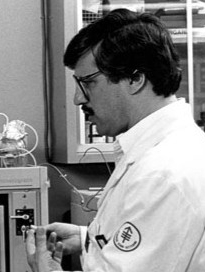A phase I trial of intraperitoneal recombinant interleukin 2 in patients with ovarian carcinoma Journal Article
| Authors: | Chapman, P. B.; Kolitz, J. E.; Hakes, T. B.; Gabrilove, J. L.; Welte, K.; Merluzzi, V. J.; Engert, A.; Bradley, E. C.; Konrad, M.; Mertelsmann, R. |
| Article Title: | A phase I trial of intraperitoneal recombinant interleukin 2 in patients with ovarian carcinoma |
| Abstract: | Seven patients with refractory stage III ovarian carcinoma were treated with escalating doses of human recombinant interleukin 2 (rIL-2) administered via the intraperitoneal (IP) route in an attempt to establish a dose and schedule of rIL-2 suitable for prolonged outpatient IP administration. Three patients went on to receive outpatient maintenance treatment twice weekly for 2-3 months. Doses ranged from 105 to 5 × 107 U/m2. The dose found most suitable for twice weekly outpatient IP administration was 106 U/m2. Dose-limiting toxicities consisted of diarrhea resulting in hypovolemia (5 patients) fever and chills (4 patients), nausea and vomiting (1 patient), mental status changes (2 patients), and azotemia (1 patient). These side effects were not prevented by indomethacin. Significant hypotension was not observed. Pharmacokinetic studies revealed extremely high IP concentrations of IL-2 which persisted for more than 24 hours. After a dose of 106 U/m2, the IP concentrations ranged from 670 to 760 U/ml. In one patient in whom concurrent serum concentrations were determined, the IP concentrations were over 100-fold higher than serum levels. After a dose of 107 U/m2, the IP concentrations of IL-2 ranged from 8700 to 14000. Concurrent serum levels in one patient revealed IP concentrations over 500-fold higher than serum levels. There were no consistent changes in T cell surface and activation markers on mononuclear cells from peripheral blood in 3 patients tested. Natural killer cell (NK) activity in peripheral blood increased in the three patients in whom it was measured. Four of the 7 patients progressed on treatment; 3 patients remained stable. We conclude that 106 U/m2 of rIL-2 is well-tolerated when administered by the IP route and that concentrations of IL-2 well in excess of that required to enhance cell-mediated cytotoxicity in vitro persist in the IP fluid for at least 24 hours. © 1988 Kluwer Academic Publishers. |
| Keywords: | adult; clinical article; aged; diarrhea; ovarian neoplasms; interleukin 2; ovary cancer; anemia; fever; liver; kidney; brain; indometacin; recombinant proteins; phase 1 clinical trial; tissue level; ovarian carcinoma; bioavailability; interleukin-2; blood level; middle age; drug evaluation; hypovolemia; intraperitoneal drug administration; injections, intraperitoneal; uremia; human; female; priority journal; support, non-u.s. gov't; support, u.s. gov't, p.h.s.; intraperitoneal interleukin 2 |
| Journal Title: | Investigational New Drugs |
| Volume: | 6 |
| Issue: | 3 |
| ISSN: | 0167-6997 |
| Publisher: | Springer |
| Date Published: | 1988-09-01 |
| Start Page: | 179 |
| End Page: | 188 |
| Language: | English |
| DOI: | 10.1007/bf00175395 |
| PUBMED: | 3263958 |
| PROVIDER: | scopus |
| DOI/URL: | |
| Notes: | Article -- Source: Scopus |
Altmetric
Citation Impact
BMJ Impact Analytics
Related MSK Work







